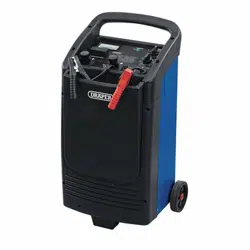Loading ...
Loading ...
Loading ...

Ground
(Negative)
PERCENT OF CHARGE
The percent of charge scale in intended as a visual aid to help simplify reading the state of charge.
BATTERY TYPES
Three basic types of lead-acid batteries can be given a charge with this charger:
(1) Conventional and Low Maintenance,
(2) Maintenance Free,
(3) Deep Cycle.
Conventional and Low Maintenance
Batteries. These are the antimony/lead batteries. Conventional/Low Maintenance batteries require
periodic addition of water to the acid solution (electrolyte). Additional water may be added by
removing the filler caps located on the top of the battery.
Important: When antimony is known to be one of the materials, used in the battery's
construction, that battery is a Low Maintenance/Conventional type.
Caution: Some Low Maintenance batteries have a relatively smooth top without any apparent
battery filler caps. If, however the battery manufacturer/distributor recommends periodic
checking of electrolyte level and provides access to the battery for water additions, the battery
is probably a Low Maintenance/Conventional type.
Maintenance free batteries, AGM & Gel.
(low maintenance batteries)
These batteries often have cells with no filler caps and therefore cannot be topped up with distilled
water if using a taditional charger for charging these batteries, it is important that during the
charging they are not allowed to “gas” because this will reduce the level of electrolyte which
cannot be replaced. You should take extra care when the battery reaches “full” during charging
and do not use the “fast” charge option on such batteries.
Deep Cycle Batteries.
These heavy duty batteries are used in boats, construction equipment, sump pumps, etc. They are
normally marked DEEP CYCLE on the outside of the case.
OPERATING INSTRUCTIONS: CHARGING BATTERY IN VEHICLE
When charging battery in the vehicle, take care to determine the battery type and which post is
grounded. To reduce risk of a spark near battery, follow these steps when battery is installed in
vehicle.
Warning: A spark near battery may cause battery explosion.
1. Position AC power cord and DC charging cords to reduce risk of damage by hood, door, or
moving engine parts.
2. Stay clear of fan blades, belts, pulleys, and
other parts that can cause injury.
3. Check polarity of battery posts. Battery
case will be marked by each post:
POSITIVE (POS, P, +) and NEGATIVE
(NEG, N, -). NOTE: The positive battery
post usually has a larger diameter than the
negative post.
4. Determine which post of battery is ground
(connected) to chassis.
Note: The negative post is normally grounded.
FIG.6
9. OPERATION AND USE
- 16 -
Loading ...
Loading ...
Loading ...
